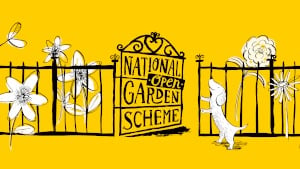About Cherry Orchard Barn
We created the garden at Cherry Orchard Barn as part of a project to convert a nineteenth-century threshing barn and cattle byre into our home.
The buildings were derelict and the land rough with a mixture of clay and Cotswold brash. There were a few self-seeded ash trees and a short length of field maple hedge. Other than these it was a blank, but challenging canvas from which we have crafted a garden, which we hope you will enjoy. Possibly returning to see us over the years as the garden matures.
A theme of circles is picked up throughout the garden.
The Pond Garden forms an enclosed courtyard between the two buildings, receiving the morning and afternoon sun. This was the first area to be landscaped, with curved beds around a round pond and gravel ‘donut’, contained within a rope catenary. The planting scheme here is of pinks, lilacs and whites, with roses, clematis, salvia, agastache, lavender, geranium, cosmos, nepeta and clouds of Verbena bonariensis and ammi.
The Circular-Lawn Garden sits to the south of the threshing barn. Its deep borders are filled with fresh tones of white, pale yellows and blues. In the winter, the copper foliage five columns of beech mimic the brick pillars which support the cattle byre. Roses, hydrangeas, grasses, nepeta, phlomis, geranium, iris, helianthus, gaura and dahlia grow here.
The Parterre was the most recent garden to be planted. It is formed of six beds around a circular brick column topped by a sculpture by Bath artist, Caspar Taylor.
The planting here enjoys a long season and is rich with colours that glow in the afternoon and evening sun. Geum, dahlia, lysimachia, persicaria, roses, sanguisorba, cosmos, rudbeckia, achillia and grasses are in these beds.
Beyond the Parterre is a large lawned area with young shrubs and spring bulbs. There are splendid pastoral views from the west end of the garden towards Badminton Deer Park.
The Green Room picks up the circular theme with a ring of Pyrus Chanticleer in a simple lawn, bordered by yew.
There is also a modest Kitchen Garden, with raised beds, and a small Orchard.
.

.jpg)
.jpg)
.jpg)
.jpg)
.jpg)
.jpg)
.jpg)
.jpg)
.jpg)
.jpg)
.jpg)
.jpg)
.jpg)
.jpg)
.jpg)
.jpg)
.jpg)
.jpg)



.jpg)
.jpg)
.jpg)
.jpg)
.jpg)